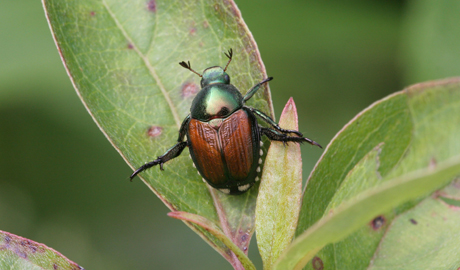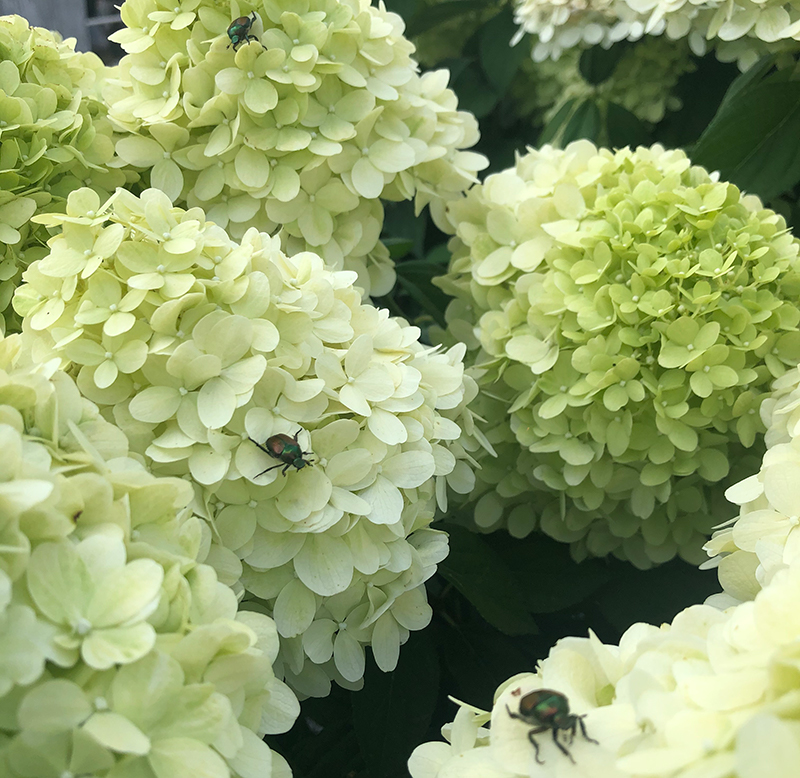Battling Japanese Beetles

How to protect your garden
Japanese beetles are arguably central Pennsylvania’s worst garden pest. They first appeared in New Jersey either in 1916 in nursery stock from Japan or in the early 1930s in nursery stock from Korea, depending on whose version you believe. Not only do adult beetles eat a few hundred different types of plants (they’re not very picky), but their offspring (the dreaded white grubs) feed on lawn roots in spring and fall. In other words, they’re double trouble.
Knowing the enemy
The adults are about half of an inch long with metallic green bodies and coppery wings. They do most of their damage to plants from the end of June through early August. They chew leaf tissue between the veins, leaving skeletonized foliage in their wake. Although they’re known to attack about 400 plant species, beetles tend to favor roses, grapes, ornamental fruit trees, zinnias, Virginia creepers, Boston ivy, birch trees, cannas and marigolds. The adults spend most of their brief life feeding and mating. Females start laying eggs within days, usually 2 to 4 inches deep in sunny spots of the lawn. In an average season, each female lays about 50 eggs.
The eggs hatch in 10 to 30 days, producing the C-shaped white grubs that start feeding on lawn roots from August into fall. If enough grubs are around, you’ll start to notice irregular patches of browned-out grass that pulls up easily like a carpet. Since skunks and birds love to go grub-hunting, you also might notice some secondary damage as those animals tear up the lawn in search of food. Beetle eggs need moisture to hatch, which is why beetle outbreaks are often worst the year after a wet summer.
Attacking the adults
Phase One of your anti-beetle campaign is to go after the adults when they start to chew your plant leaves. One effective approach, though more time consuming, is to hand-brush the beetles off of your plant, dropping them into a soapy water bucket. They will be unable to escape, and you can discard them when finished.
You can also use a variety of insecticides that when sprayed or dusted on plants will kill the beetles, including Sevin (carbaryl), Seven Complete Insect Killer, Bayer Copmplete Insect Killer, Bonide Captain Jack (spinosad), Ortho Bug B Gon (acetamiprid), Ortho Rose & Flower (acetamiprid) and pyrethrins. These products may need to be reapplied every 7 to 14 days or after rains for maximum effectiveness. Read the labels for dilution rates and recautions.
Another approach is to repel beetles by using a neem oil spray (azadirachtin). This is a botanical insecticide that’s an extract of the seeds of the tropical neem tree. Beetles (and many other bugs, for that matter) apparently do not like its odor, so it can be sprayed every 7 to 10 days on plants you want to protect. There’s also evidence that neem may disrupt beetles’ growth hormones if they eat leaves treated with it. Once again, read the label for use instructions.
Beetle traps
One of the most commonly used anti-beetle products is the Japanese beetle trap. These traps are plastic contraptions that use a beetle mating scent to attract beetles into an attached bag from which they cannot escape. Gardeners like them because they can see hundreds of beetle bodies in the bag, assuring them that the things are working. The problem is the scent works so well that it attracts beetles from as far as a half of a mile away.
So if you’re the only one using a trap, you’ll be luring in beetles from everyone else’s yard. (At least you’ll be a popular neighbor.) The bottom line is that damage to your plants could be even worse than if you had done nothing. Traps can be useful if you place them well away from special plants you want to protect, or better yet, if you give a few of them to your neighbors!

Going after the grubs
Another effective way to lessen your beetle problem is to hit the enemy in its weakest link – the grub stage. After adult beetles lay their eggs, the baby grubs stay fairly high up in the soil feeding on those roots. They’ll stay there until the weather gets cold, at which time they burrow deeper into the ground to overwinter. This means your best chance to get the grubs is late summer into early fall. The absolute best time to kill grubs is right after they hatch, when they’re youngest and most vulnerable. Get them by applying a granular or spray insecticide to the lawn.
It’s best to put down Merit as soon as you see the adult beetles flying around through mid-August. And if you need to reuse your lawn use Bayer 24-hour grub killer plus contains dylox, They also can be put down in July or August and can be reapplied in late summer or very early fall if any latecomers are still causing lawn damage. All of the granular lawn insecticides should be watered in after applying so they can go to work immediately. And if you need to rescue your lawn use Bayer 24 hour Grub Killer plus contains Dylox.
Some Maples can be sensitive to chemicals. Test an area of the tree before spraying the entire plant.
Another approach is to repel beetles by using a neem oil spray (azadirachtin). This is a botanical insecticide that’s an extract of the seeds of the tropical neem tree. Beetles (and many other bugs, for that matter) apparently do not like its odor, so it can be sprayed every 7 to 10 days on plants you want to protect. There’s also evidence that neem may disrupt beetles’ growth hormones if they eat leaves treated with it. Once again, read the label for use instructions.
Plants that Japanese beetles rarely attack:
Arborvitae, Ash, Boxwood, Cedar, Dogwood, Euonymus, Forsythia, Holly, Hydrangea, Juniper, Lilac, Magnolia, Privet, Red oak, Red maple, Silver maple, Spruce, Tulip tree, and Yew.
